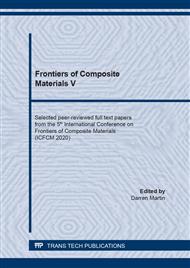p.3
p.11
p.17
p.23
p.29
p.37
p.47
p.57
Effect of Fiber Loading on the Chemical, Structural and Mechanical Properties of 3D Printed Polylactic Acid/Abaca Microcrystalline Cellulose Composites
Abstract:
In an attempt to improve the physical properties of 3D printed poly lactic acid (PLA), this study aims to develop a microcrystalline cellulose fiber and observe the effects of fiber loading on the PLA/cellulose composites to the composition, crystallinity, morphology, and tensile properties of the resulting 3D printed material. Microcrystalline cellulose (MCC) have been extracted from indigenous raw abaca fibers and used as the fiber reinforcement for the PLA matrix. Composites of 1 and 3 wt% MCC fibers with PLA were processed using the twin-screw extruder to produce filaments. The resulting composite filaments were 3D printed utilizing the fused deposition modeling technology. FTIR, XRD, digital microscopy, and mechanical testing were used in characterizing the various 3D printed PLA/MCC composite. With the incorporation of cellulose, the PLA/MCC had up to 32% increase in tensile strength and 43% increase in modulus at just 3 wt% fiber loading due to the inherent high modulus of abaca cellulose. The MCC significantly influences the chemical, structural and mechanical properties of the 3D printed PLA/MCC composites.
Info:
Periodical:
Pages:
3-9
Citation:
Online since:
August 2021
Price:
Сopyright:
© 2021 Trans Tech Publications Ltd. All Rights Reserved
Share:
Citation:


